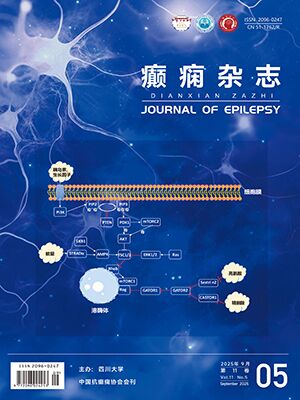| 1. |
Specchio N, Wirrell EC, Scheffer IE, et al. International League Against Epilepsy classification and definition of epilepsy syndromes with onset in childhood: Position paper by the ILAE Task Force on Nosology and Definitions. Epilepsia, 2022, 63(6): 1398-1442.
|
| 2. |
杨志仙, 钱萍. 睡眠中癫痫性电持续状态的研究进展. 中华实用儿科临床杂志, 2017, 32(12): 6.
|
| 3. |
Guerrini R. Epilepsy in children. Lancet, 2006, 367(9509): 499-524.
|
| 4. |
Liu MJ, Su XJ, Md XS, et al. Clinical features of benign epilepsy of childhood with centrotemporal spikes in Chinese children. Medicine (Baltimore), 2017, 96(4): e5623.
|
| 5. |
Doumlele K, Friedman D, Buchhalter J, et al. Sudden unexpected death in epilepsy among patients with benign childhood epilepsy with centrotemporal spikes. JAMA Neurol, 2017, 74(6): 645-649.
|
| 6. |
Rubboli G, Gardella E, Cantalupo G, et al. Encephalopathy related to status epilepticus during slow sleep (ESES): Pathophysiological insights and nosological considerations. Epilepsy Behav, 2023, 140: 109105.
|
| 7. |
李晓, 蒋莉. Rolandic癫痫的遗传病学研究进展. 中华实用儿科临床杂志, 2020, 35(4): 314-317.
|
| 8. |
唐兰芳, 胡越. 激素联合抗癫痫药物治疗儿童睡眠中癫痫性电持续状态有效性和安全性的Meta分析. 癫痫杂志, 2021, 7(3): 197-207.
|
| 9. |
束明珠, 石褀, 王小姗. 儿童良性癫痫伴中央颞区棘波的研究进展. 癫痫杂志, 2021, 7(4): 335-339.
|
| 10. |
毛云青, 刘龙芳, 杨萍萍. 伴中央颞区棘波的自限性癫痫脑电图特征及睡眠中癫痫电持续状态危险因素分析. 罕少疾病杂志, 2023, 30(12): 13-14.
|
| 11. |
王健, 刘灿, 李秋波. 儿童良性癫痫伴中央颞区棘波的演化机制研究进展. 临床神经病学杂志, 2022, 35(3): 35.
|
| 12. |
Tovia E, Goldberg-Stern H, Zeev BB, et al. The prevalence of atypical presentations and comorbidities of benign childhood epilepsy with centrotemporal spikes. Epilepsia, 2011, 52(8): 1483-1488.
|
| 13. |
Kim H, Kim S Y, Lim B C, et al. Spike persistence and normalization in benign epilepsy with centrotemporal spikes–Implications for management. Brain Dev, 2018, 40(8): 693-698.
|
| 14. |
Wang X, Zhang Y, Sun R, et al. Risk factors of electrical status epilepticus during sleep in children with benign childhood epilepsy with centro-temporal spikes. Pak J Med Sci, 2024, 40(4): 612.
|
| 15. |
Nicolai J, Aldenkamp AP, Arends J, et al. Cognitive and behavioral effects of nocturnal epileptiform discharges in children with benign childhood epilepsy with centrotemporal spikes. Epilepsy Behav, 2006, 8(1): 56-70.
|
| 16. |
Lee YJ, Hwang SK, Kwon S. The Clinical Spectrum of Benign Epilepsy with Centro-Temporal Spikes: a Challenge in Categorization and Predictability. J Epilepsy Res, 2017, 7(1): 1-6.
|
| 17. |
Kanemura H, Sano F, Aoyagi K, et al. Do sequential EEG changes predict atypical clinical features in rolandic epilepsy? Dev Med Child Neurol, 2012, 54(10): 912-917.
|
| 18. |
Smith AB, Bajomo O, Pal DK. A meta-analysis of literacy and language in children with rolandic epilepsy. Dev Med Child Neurol, 2015, 57(11): 1019-1026.
|
| 19. |
Licchetta L, Vignatelli L, Zenesini C, et al. Sleep-related hypermotor epilepsy: a prediction cohort study on sleep/awake patterns of seizures. Epilepsia, 2019, 60(11): e115-e120.
|
| 20. |
Lindgren S, Kihlgren M, Melin L, et al. Development of cognitive functions in children with rolandic epilepsy. Epilepsy Behav, 2004, 5(6): 903-910.
|
| 21. |
Kramer U, Sagi L, Goldberg-Stern H, et al. Clinical spectrum and medical treatment of children with electrical status epilepticus in sleep (ESES). Epilepsia, 2009, 50(6): 1517-1524.
|
| 22. |
Kobayashi K, Yoshinaga H, Toda Y, et al. High-frequency oscillations in idiopathic partial epilepsy of childhood. Epilepsia, 2011, 52(10): 1812-1819.
|
| 23. |
He W, Liu H, Liu Z, et al. Electrical status epilepticus in sleep affects intrinsically connected networks in patients with benign childhood epilepsy with centrotemporal spikes. Epilepsy Behav, 2020, 106(1): 107032.
|
| 24. |
Huang X, Zhang X, Wang X, et al. A nomogram to predict symptomatic epilepsy in patients with radiation-induced brain necrosis. Neurology, 2020, 95(10): e1392-e1403.
|




